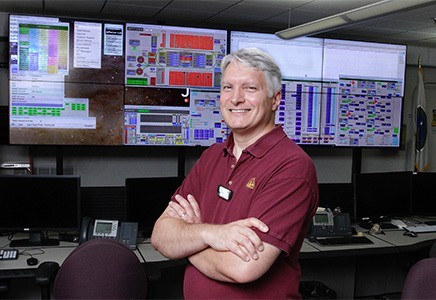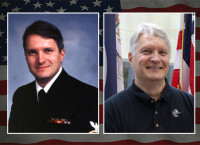
Vasilauskis' job is to make sure his team is trained, prepared and available to run Jefferson Lab’s electron accelerator. His training running nuclear power plants for large military carriers was strong training grounds for managing a team of operators and crew chiefs at the lab.
A tinkerer from the Navy finds purpose at Jefferson Lab
Paul Vasilauskis grew up in the South suburbs of Chicago riding his bike through miles of large abandoned farm fields rich with ponds, creeks and wooded areas. He devoured rows of books and magazines. “Popular Mechanics” and “Mechanics Illustrated” were his favorite. “I used to sit downstairs in the spare room and just read from the encyclopedia and old magazines especially anything that said ‘atomic’ or ‘nuclear’ in it,” he said.
But mostly, he was a tinkerer. Once, after exploring the warm glowing tubes inside his family’s television it would no longer turn on and when cross-examined by his parents later, claimed “I don’t know what happened, it just stopped working. I don’t think there was anything in the house I hadn’t torn apart to see how it worked,” Vasilauskis said.
A young explorer
Vasilauskis discovered his mechanical skills early and, with practice, they developed. His father, who worked for the United States Post Office, indirectly encouraged his son’s mechanical skills by providing him real-life opportunities to tinker. Vasilauskis recalled a moment when his father became frustrated with their “crotchety, old snow blower.”
“He would get frustrated,” he said. “Then I would fuss with it, and I’d get it running.” As a high school student, Vasilauskis thrived in his computer programming class. At the time, he was working for a small business run by his friend’s family making small, plastic clocks for $3 an hour. “It was mindless, repetitive work,” he remembered. “I would be sitting there putting these clocks together but in my head, I would write my software programs.”
By his senior year, he was ready to continue on with a second year of writing programs, but there were no system operators available at the start of the year to run them. “I was taught how to run an IBM 360 mainframe,” he said. This was his first exposure to being an operator, his second came from the Navy.
From the Navy to Jefferson Lab
After Vasilauskis graduated high school, he visited a recruiter for the United States Navy where his testing results revealed his natural talent for science and mechanics. After finishing the test, the recruiter put his arm around Vasilauskis and said, “Has anyone ever told you about our nuclear power program?” Vasilauskis was intrigued. He could learn how to operate a nuclear reactor at the age of 18, and said he was always on board for anything “science-y and technical.” He joined the Navy in 1981, and in 1990 he was transferred to Newport News where he attended an open house held at Jefferson Lab. He still has the poster from that visit. “I remember them showing us about the fabrication of the niobium cavities,” he said. “We got a tour of a very large and empty hall. In that hall was a mock-up of a piece of a detector.”
He didn’t know it then, but a little more than a decade later, he would become the Accelerator Operations Group Leader, helping manage the teams that work with that accelerator and that very hall. His two decades in the Navy as a reactor operator molded Vasilauskis into the methodical thinker and worker he is today. During his time, he deployed five different times visiting Hawaii, the Indian Ocean, the Mediterranean, Greece, the Suez Canal, and Persian Gulf. In September 2001, Vasilauskis walked off his last Navy ship as an enlisted man and not long after walked into his first-ever, and only job interview at Jefferson Lab.
Rising through the ranks
He started as an operator of the accelerator, then was promoted to Crew Chief. Now, as the Accelerator Operations Group Leader, he oversees the Crew Chiefs and operators. He serves as the interface between upper management and the team on the ground working directly with the accelerator. “I rose up through that chain,” he said. “Now I get to make sure they have everything they need.”
For Vasilauskis, this means organization. When the accelerator is turned on, the amount of time it runs is determined by the Federal budget, Physics, and maintenance schedules. During those weeks, the accelerator will run 24 hours a day, 7 days a week. The operators manning shifts need proper, updated knowledge and information to constantly monitor the machine and its several hundred thousand parameters. The Crew Chiefs need a plan that ensures everything is prepared and integrated for experiments to run.
For all of this to happen smoothly, it takes communication and planning between the physicists who need the accelerator for research and the engineers who need to perform maintenance on the accelerator for it to complete the research. To coordinate all these activities, a master plan is created between Physics and Operations, for up to a year in advance.
Vasilauskis and his supervisors will set the schedule of operators and Crew Chiefs who will run the accelerator making sure that everything that needs to happens every hour of the day and night. “Before we start up, we have to go through and sweep it,” he explained. This includes a team physically walking the mile of tunnel to ensure all is well and clear of personnel.
After locking it up, a redundant personal safety system monitors all points of entry to ensure no personnel can enter the tunnel. Then they begin the accelerator set up where the operators work with accelerator scientists to examine and fine-tune the optics of the beam. Once everything is ready, the accelerator can run to multiple experiments installed in up to four separate beam destinations at the same time.
The mechanic at home
It was during his third year in the Navy, on a trip home visiting family in Chicago, when Vasilauskis met his wife through mutual friends. Fourteen years later, they had twin girls. His wife works in data analysis for the Department of the Navy in the shipyard, and his daughters are both pursuing their education: one is a sophomore at Thomas Nelson planning to be a forensic psychologist, and the other is at Savannah College of Art and Design studying animation.
Vasilauskis lives across the James River Bridge in Carrollton and when he isn’t at the lab, he works on his amateur radio that he built himself. With his radio he has successfully made contact with 56 localities, including another amateur radio operator in Lithuania, the origin of the Vasilauskis’ last name.
From smashing rolls of red paper caps on the garage floor with his dad’s largest hammer to managing a team of people running the CEBAF accelerator, Vasilauskis has always been a problem-solver. A problem-solver who listens to Duran Duran, enjoys shrimp and crab legs, and completing a good day of work at Jefferson Lab. “I like to do the right thing,” he said. “Not just what we’ve always done or just what is needed.” And then he added, “I won’t pass up lobster either.”
"Nuclear training has given me a wide spectrum of understanding on how things work from electronics, to the electrical and mechanical aspects and more," said Vasilauskis. "All of these things have helped me greatly as an Operator and a Crew Chief here at Jefferson Lab."


